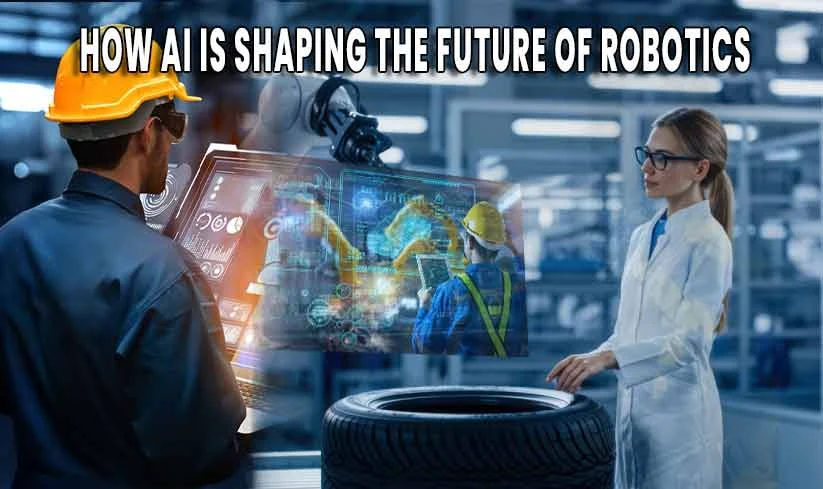How AI Is Shaping the Future of Robotics
The fusion of artificial intelligence (AI) and robotics is transforming industries, economies, and daily life. As AI continues to evolve, robots are becoming smarter, more autonomous, and capable of performing complex tasks with precision. From manufacturing and healthcare to space exploration and household assistance, AI-powered robotics is redefining what machines can achieve.
This article explores the key ways AI is shaping the future of robotics, including advancements in machine learning, computer vision, natural language processing, and autonomous decision-making. We will also discuss the ethical implications, challenges, and potential future developments in this rapidly evolving field.
1. AI Enhances Robot Autonomy
Traditional robots operate based on pre-programmed instructions, limiting their ability to adapt to new situations. AI changes this by enabling robots to learn from their environment and make real-time decisions.
Machine Learning in Robotics
Machine learning (ML) allows robots to analyze data, recognize patterns, and improve performance over time. For example:
- Industrial robots in manufacturing can optimize production lines by learning from past errors.
- Agricultural robots use ML to identify crops, detect diseases, and apply pesticides efficiently.
- Autonomous drones adjust flight paths based on weather conditions and obstacles.
Reinforcement Learning for Adaptive Behavior
Reinforcement learning (RL) enables robots to learn through trial and error, much like humans. Boston Dynamics' robots, such as Spot and Atlas, use RL to navigate uneven terrain and recover from falls. In the future, RL could allow robots to perform complex tasks like disaster rescue operations with minimal human intervention.
2. Computer Vision and Perception
AI-powered computer vision allows robots to "see" and interpret their surroundings with remarkable accuracy.
Object Recognition and Scene Understanding
Robots equipped with deep learning models can:
- Identify objects in cluttered environments (e.g., Amazon’s warehouse robots).
- Assist in medical surgeries by recognizing tissues and organs with precision.
- Enable self-driving cars to detect pedestrians, traffic signs, and obstacles.
3D Vision and Depth Sensing
Advanced sensors like LiDAR and stereo cameras help robots perceive depth, improving navigation and manipulation. For instance:
- Delivery robots use 3D mapping to navigate sidewalks and avoid collisions.
- Robotic arms in assembly lines precisely pick and place objects using depth perception.
3. Natural Language Processing (NLP) for Human-Robot Interaction
AI-driven NLP allows robots to understand and respond to human speech, making them more interactive and user-friendly.
Voice-Controlled Assistants
Robots like Amazon Astro and SoftBank’s Pepper use NLP to answer questions, follow commands, and assist in daily tasks. Future advancements may enable robots to hold natural conversations, understand emotions, and provide companionship.
Multilingual and Context-Aware Communication
AI models like GPT-4 and Google’s BERT enhance robots' ability to comprehend context, slang, and multiple languages. This is crucial for customer service robots in global markets.
4. AI in Collaborative Robotics (Cobots)
Collaborative robots (cobots) work alongside humans, enhancing productivity and safety. AI makes them more intuitive and adaptable.
Human-Robot Collaboration in Manufacturing
- Cobots like Universal Robots’ arms adjust their speed and force based on human proximity to prevent accidents.
- AI algorithms predict worker movements, allowing seamless teamwork.
Healthcare and Surgical Robots
- Da Vinci Surgical System uses AI to assist surgeons with precision in minimally invasive procedures.
- Rehabilitation robots adapt therapy exercises based on patient progress.
5. Autonomous Robots in Logistics and Transportation
AI is revolutionizing logistics with self-driving vehicles and automated warehouses.
Self-Driving Delivery Robots
Companies like Starship Technologies and Nuro deploy autonomous robots for last-mile deliveries, reducing costs and improving efficiency.
AI in Warehouse Automation
- Amazon’s Kiva robots navigate warehouses, fetching items for packing without human guidance.
- AI optimizes inventory management, predicting stock demands in real time.
6. AI in Space and Exploration Robotics
NASA and SpaceX use AI-powered robots for space missions where human presence is risky or impossible.
Mars Rovers (Perseverance, Curiosity)
- AI helps rovers analyze soil samples, avoid hazards, and select optimal paths.
- Machine learning algorithms process vast amounts of planetary data for scientific discovery.
Autonomous Repair Drones
Future space missions may deploy AI-driven drones to repair satellites and space stations autonomously.
7. Ethical and Societal Implications
While AI-driven robotics offers immense benefits, it also raises ethical concerns:
Job Displacement
Automation may replace certain jobs, requiring workforce reskilling. Governments and industries must prepare for this shift.
Bias in AI Decision-Making
If training data is biased, robots may make unfair decisions (e.g., hiring or law enforcement robots). Ensuring ethical AI development is crucial.
Security Risks
Hackers could exploit AI-powered robots for malicious purposes. Strong cybersecurity measures are essential.
8. The Future of AI and Robotics
The next decade will see even more groundbreaking advancements:
- General-Purpose Robots: AI may enable robots to perform a wide range of tasks without specialized programming.
- Emotionally Intelligent Robots: Future robots could recognize and respond to human emotions, improving caregiving and companionship.
- Swarm Robotics: AI-controlled robot swarms (e.g., for search-and-rescue or construction) will collaborate like insect colonies.
- Brain-Computer Interfaces (BCIs): AI could allow humans to control robots with their thoughts, benefiting paralyzed individuals.
Conclusion
AI is the driving force behind the next generation of robotics, making machines smarter, more autonomous, and more integrated into our lives. From manufacturing and healthcare to space exploration and daily assistance, AI-powered robots are reshaping industries and pushing the boundaries of innovation.
However, as this technology advances, addressing ethical concerns, ensuring security, and preparing for societal impacts will be critical. The future of robotics is not just about technological progress but also about responsible and inclusive development.
As AI continues to evolve, the line between human and machine capabilities will blur, opening up unprecedented possibilities for the future of robotics.






